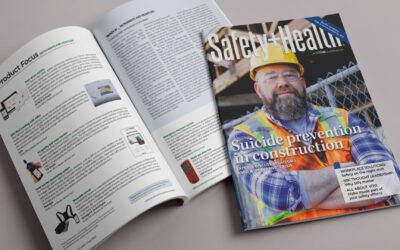A series of short interviews with some of the brightest minds in our space.
Over the past few months, we have been doing a LinkedIn series featuring various professionals who have dedicated their careers to workplace safety, injury prevention, technology, the future of work and so much more. In the series, we ask one question relevant to the overlap of our industries to pass on valuable insights to our audience from industry experts.
The following is a live blog, updated with all of our one question interviews to date.

We asked Nicole Stempak, a managing editor at EHS Today, for the trend in EHS technology that has the largest potential to change how we view safety in the workplace.
“We need to approach safety technology as a cost savings rather than an expense. Until we do, we can’t unlock technology’s potential to create a safer workplace.”

We asked Director of #WorkToZero at NSC, Emily Whitcomb, for the biggest trend in workplace safety technology that not enough people are talking about right now.
“Technologies not only have the power to remove workers from dangerous jobs in the workplace, saving lives, they also have the power to improve operational efficiencies, allowing companies to expand operations at a lower cost of production. Additionally, by using tech to collect data, EHS professionals are no longer relying on interviews and lagging indicators but can rely on science and proactively respond before a worker gets hurt.”

We asked safety philosopher and author, Wyatt Bradbury, what he thinks will be the most important development in safety technology over the next few years and how he sees it impacting the workplace.
“One of the most important technological developments in the workplace will not be a new technology, rather better integration of a technology almost all employees use on a daily basis. Smartphones provide immense opportunity for safety professionals and organizations to increase, capture, and digitize data that is otherwise going unrecorded. I think there is opportunity for organizations to leverage this access supporting employee engagement in safety. In turn, that engagement can provide knowledge that, when used, will drive further learning and opportunity.”

We asked occupational athletic trainer and independent researcher, Scott Mullett, which trends he sees most frequently as the cause of ergonomic injuries at work, and the most effective types of prevention.
“I strive to keep employees safe and healthy. Whether that’s developing preventative exercises and stretches, to implementing workplace ergonomic controls, the health and safety of employees are my priorities. However, common trends that lead to ergonomic related injuries within the workplace include: inadequate pre-job warm up routines, poor posture and biomechanics, tasks which are highly repetitive, and outdated workstation design. Implementation of pre-job warm-up routines and ergonomic controls will reduce injuries and improve the health and safety of the workforce.”

We asked the founder and CEO of SkyHive Technologies, Sean Hinton, for one piece of advice he would give to new managers looking to get the best out of their employees, and how technology could play a role.
“The question should not be how managers can get the best out of their employees, but how managers can empower and support employees to get the best out of themselves. Technological advancements in people technology such as the application of artificial intelligence are democratizing career pathway visualization for employees and enabling employees to ‘chart their own course.’ Today, employees can now see the skills they have, the skills and jobs that are in-demand by their employer, the gaps they have to those roles and the clear reskilling/upskilling pathways to become ready for those in-demand roles.”

We asked tech entrepreneur and author of “Blitzscaling” Chris Yeh about the state of the future of work in 2022.
“One new reality of work in 2022 that might surprise people is the importance of intentional in-person gatherings. This is not a “back to normal” with everyone in the office five days per week. But during the past few years, we have been burning our accumulated relationship capital without replenishing it, as if it were a fossil fuel. We need to generate a renewable source of relationship capital so that the new employees we’ve hired during the Covid era feel just as connected as the old guard.”




